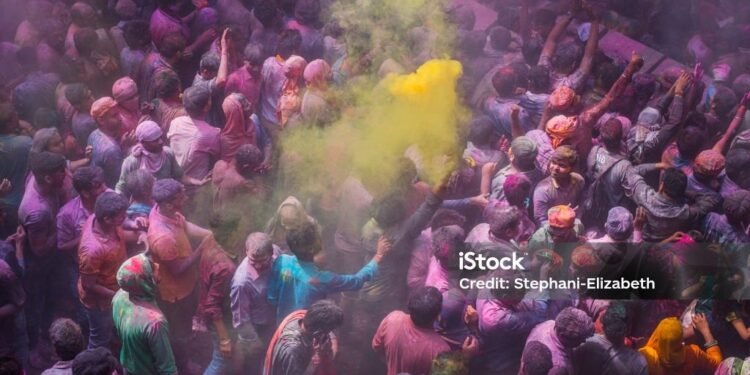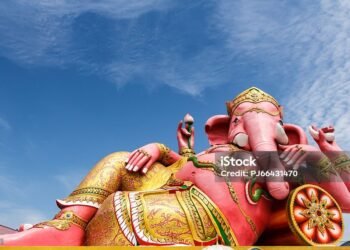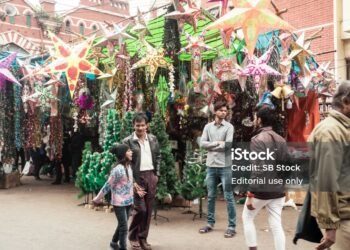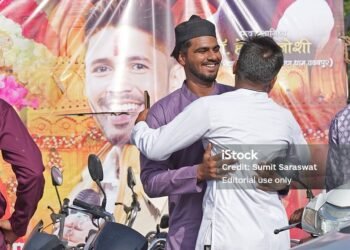Introduction
Holi, known as the “Festival of Colors,” is one of India’s most exuberant and widely celebrated festivals, embodying the joy of spring, the triumph of good over evil, and the suspension of everyday boundaries in a spirit of playful unity. Taking place in March on the full-moon day of Phalguna, Holi bathes cities, villages, and hearts in clouds of vibrant gulal (colored powders), infectious laughter, and collective celebration. With ancient mythological roots and spectacular regional variations—especially in Braj—the festival beautifully blends devotion, mischief, and renewal.

Context and Origins
Holi’s origins are deeply rooted in ancient Indian legends and agricultural cycles. It marks winter’s end and spring’s arrival, invoking both fertility and hope. The festival’s mythology is anchored by two main stories:
Prahlad and Holika: The demon king Hiranyakashipu tries to kill his devout son Prahlad with the help of his fire-immune sister Holika. But divine intervention saves Prahlad, burning Holika instead—symbolizing the triumph of virtue and faith over evil.
Krishna and Radha: In Braj, Holi recalls the playful pranks of Lord Krishna, who, feeling self-conscious about his dark skin, colored Radha’s face to make her like him. This legend inspires Holi’s joyous color play and its intimate, teasing spirit.
Key Features and Vocabulary
Holika Dahan: The ritual bonfire lit on the night before Holi, representing the burning away of negativity and the victory of good over evil.
Gulal and Abir: Vibrant colored powders used for throwing, smearing, and dousing friends, family, and strangers in riotous fun.
Pichkari: Water guns and syringes designed for spraying colored water, especially popular with children.
Rangwali Holi / Dhulandi: The main day’s festivities, marked by mass gatherings, singing, dancing, and communal eating.
Bhang and Thandai: Festival drinks, often made with milk, nuts, spices, and (sometimes) cannabis leaves, adding to the carefree mood.
Rangoli: Decorative floor designs made at home entrances to welcome joy and luck.
Evolution and Regional Rituals
General Observance
Holika Dahan (Eve of Holi): Effigies of Holika are burned in huge bonfires, sometimes accompanied by folk songs and prayers. Families gather to offer rituals and burn away old grievances.
Rangwali Holi (Main Day): Begins at sunrise as people take to streets, splattering colors, dousing each other with water, and singing songs until midday.
Braj (Mathura, Vrindavan, Barsana, Nandgaon)
Holi in Braj is legendary for its passionate and unique customs:
Phoolon Wali Holi: Celebrated with showers of flower petals, especially at Banke Bihari Temple, Vrindavan.
Lathmar Holi: In Barsana and Nandgaon, women “beat” men playfully with sticks as men shield themselves, enacting Radha and Krishna’s legendary teasing—an energetic spectacle of gendered humor and camaraderie.
Widow’s Holi: In Vrindavan, widowed women, previously excluded from celebration, now take part in vibrant color play.
Holika Dahan in Mathura: Processions, bonfires, and devotional singing mark the spiritual beginning.
Ras Leela: Dramatic re-enactments of Krishna’s dances with the gopis, blending performance, devotion, and storytelling.
Naga Dola and Dauji ka Huranga: Ritual processions, temple celebrations, and playful wrestling and color-throwing in Mathura and surrounding villages.
Pan-Indian Variations
Eastern India (West Bengal, Odisha): Holi coincides with “Dol Yatra” or “Dol Purnima”, with swings, bhajans, and serene festivities.
South India: Holi is lower-key, incorporating local traditions and sometimes connecting with Kama Dahanam, a festival commemorating the god Kama’s incineration and rebirth.
Techniques and Rituals
Preparation: Days in advance, people collect wood and materials for the Holika pyre.
Color Play: Natural and synthetic powders, water balloons, and pichkaris are used for riotous fun; groups go from house to house, singing and drumming.
Feasting: Signature foods include gujiya (sweet dumplings), malpua, mathri, and festive drinks like thandai, often spiced with bhang.
Community Spirit: Class, age, gender, and caste hierarchies are symbolically set aside; neighbors, friends, and even strangers join hands.
How to Read or Experience Holi
Join early morning color battles in local parks or streets—wear white to let colors show.
Witness Holika Dahan for a moving start to the celebration.
Visit Braj for Lathmar Holi, Phoolon Wali Holi, and Ras Leela for an immersive, traditional experience.
Enjoy festive foods and the unique flavors of bhang or thandai.
Observe the playful upending of social conventions and the festival’s deep-rooted sense of joy and renewal.
Contemporary Relevance and Legacy
Global Reach: Holi is now celebrated by Indian communities worldwide and by people of many faiths as a celebration of inclusion, joy, and cultural unity.
Eco-awareness: Increasing emphasis on natural, skin-friendly colors and water conservation.
Social Change: Traditions like Widow’s Holi reflect the festival’s role in empowering marginalized communities and promoting inclusivity.
Economics: Holi boosts local economies through sales of colors, sweets, festive foods, and tourism.
Conclusion
Holi’s vibrant eruption of color, music, and play marks a joyful resetting of the social and natural calendar—where winter yields to spring, grievances burn away, and hearts are united in playful abandon. Rooted in powerful legends and continually renewed by regional diversity, Holi stands as a testament to India’s spirit of resilience, mischief, and joy. Whether celebrated in a quiet village or amid a jubilant urban throng, Holi invites everyone to embrace hope, forgiveness, and the unabashed thrill of being alive.





